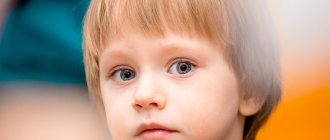Sensory alalia is a disorder in which a child’s speech does not develop due to a lack of understanding of the words of others.
This is a characteristic manifestation of disturbances in the functioning of the speech-hearing analyzer. As a result of a perinatal or postnatal complication, there is underdevelopment of some areas of the brain responsible for the perception and analysis of spoken speech.
With sensory alalia in children, in most cases, complete preservation of hearing is observed. Speech development does not occur due to the lack of connection between the sounds that the child hears and their meaning.
Symptoms of sensory alalia
The sensory alalik is not at all silent. Children have active—sometimes even overly—expressive speech. However, at the same time, they are absolutely not critical of their statements, not understanding themselves what exactly they are saying.
Characteristic features of sensory alalia:
- The mindless repetition of frequently heard phrases is echolalia. The child may persistently repeat advertising slogans, words of cartoon characters, etc. Sometimes speech may seem meaningful if the child repeats the last word he heard along with the answer. But if you change the phrase, there will be no result.
- Frequent confusion of words, syllables and phrases, the use of made-up words - the so-called logorrhea - is another characteristic symptom of sensory alalia.
- In most cases (about 70%), hearing remains intact. However, there is instability of auditory attention. In addition, many alaliks suffer from hyperacusis - increased sensitivity to certain sounds.
- Phonemic speech perception is impaired. That is, the chain through which auditory excitation is transmitted to brain structures associated with speech “does not work” in the child.
- There are also some memory impairments. In order to remember a word or phrase, alalik requires quite a lot of repetition.
So, speech with sensory alalia is absent not because the child has disorders of the auditory or speech or articulatory apparatus, but due to the inability to form a connection between the sound of a word and an object.
Causes and symptoms of alalia in children
The causes of the disease lie in the characteristics of intrauterine or early (up to three years) development of the child:
- Fetal hypoxia or asphyxia of the newborn.
- Intrauterine infection of the fetus leading to organic brain damage.
- Traumatization of the expectant mother (falls, blows to the stomach).
- Severe diseases of a pregnant woman of a chronic nature.
- Any pathologies of delivery, including intracranial trauma of the child.
- In the first years of life, the child suffered severe and/or long-term illnesses and surgery with general anesthesia.
An unfavorable family environment and unsatisfactory social conditions aggravate the harm caused by the main etiological factors.
Alalia symptoms:
- Motor alalia - impaired coordination of movements and motor skills, memory, hyperactivity or retardation, fatigue. Speech practically does not develop or develops with a great delay, slowly, with disturbances, the vocabulary is limited, the child uses short sentences. Due to speech dysfunction, intellectual development gradually begins to suffer.
- Sensory alalia - the child does not speak, but tries very hard, reproduces sounds and sound combinations that do not make sense. For the purpose of communication, the child actively uses facial expressions and gestures. Violation of the processes of speech development causes deviations in behavior, lag in intellectual development, and mental deviations may begin.
Statistics show that alalia in its pure form is not common. A predominantly sensorimotor form of pathology is diagnosed.
Correction of sensory alalia
Classes to correct this condition are structured depending on its severity. A severe form of alalia, resulting from significant damage to areas of the brain, the child is completely unable to analyze sounds and, accordingly, understand the surrounding speech. A lighter state allows children to be aware of individual words, but not to isolate them in phrasal speech or, conversely, to perceive situationally remembered sentences and not understand words used independently.
To correct sensory alalia, a speech therapist must conduct an examination to correctly determine the severity of the condition and build a lesson plan that includes the necessary exercises and tasks.
Severe forms of this condition can lead to secondary mental and intellectual development disorders, so it is important to find a specialist who will help the child develop his speech.
Speech therapy examination of children with alalia
Children diagnosed with alalia need consultation with a neurologist, otolaryngologist, speech therapist and psychologist. The following methods are used as methods for diagnosing the degree of damage to the speech center in the brain:
- EEG;
- X-ray examination;
- Magnetic resonance imaging;
- research of the auditory center;
- echoencelography.
The specifics of a speech therapist’s work with mixed forms of alalia include assessment of the state of non-speech mental functions, auditory perception, and spatial orientation. Research includes working with subject pictures, incomplete pictures, outlines of figures, colored squares. To determine auditory gnosis, toys that make certain sounds are used. In this way, the speech therapist determines the direction and differentiation of sound.
An important aspect is violations of the child’s gross and fine motor skills. The development of brain receptors responsible for finger movements stimulates progress in normalizing speech function. Pathologies are considered to be improper coordination of arms and legs, impaired sense of balance, correct posture, range of motion, and the ability to independently complete tasks.
Tasks and exercises for sensory alalia
Speech therapy classes are conducted as part of complex therapy. At the same time, given that the violation is systemic in nature, work is being carried out “on all fronts.” The classes necessarily include exercises for the development of motor skills, attention, memory, and phonemic hearing.
It is important to consider that for children with sensory alalia, uncontrolled sound sources only slow down the correction process, overloading the psyche and not having any speech impact. Therefore, the first thing the specialist recommends is organizing regular “quiet time” in the family and generally limiting the sound environment. Against such a depleted sound background, the child’s sensitivity to speech increases. This state is used during classes.
Speech therapy work for motor alalia
Corrective action for motor alalia cannot be limited only to speech therapy work and must be of a comprehensive psychological, medical and pedagogical nature.
Drug treatment is aimed at accelerating the maturation of brain structures and relieving neurotic manifestations, which significantly facilitates subsequent speech therapy work with the child. It is very important that such treatment be carried out at the earliest possible age, since it largely normalizes the entire course of the child’s further mental and speech development. If necessary, restorative treatment is also carried out, which also helps to increase the effectiveness of speech therapy work.
The development of general and manual motor skills is important for improving the child’s motor functions, which is also necessary for normalizing his speech function. Particularly important in this regard is the development of fine motor skills of the hands, which have a great stimulating effect on speech (“the centers that control the movements of the fingers and the movements of the articulatory muscles are located in the cerebral cortex in close proximity”). To develop fine motor skills, various puppet theaters, wooden finger puppets, and lacing can help you.
To develop general motor skills, a wide variety of outdoor games are widely used, starting with those that are accessible to a child of the appropriate age and then becoming more and more complex (in terms of placing greater demands on speed and dexterity of movements). Special rhythmic exercises, especially those performed to music, as well as various dances, round dances, etc., have a great effect. One of the important tasks in the development of manual motor skills is to ensure the possibility of isolated movements of the fingers. In this regard, the so-called “trial of playing the piano” is very indicative. Slightly raising his hand with bent fingers above the table, the child must successively touch the table with each of them, starting with the thumb or little finger. The hand does not change its original position. Not every child manages to cope with this task. In some children, the fingers do not want to “separate”, and the hand bends in the most bizarre way.
Developing self-care skills in a child is of great help in the development of fine manual motor skills. You need to teach him to wash himself, brush his teeth, dry his hands with a towel, and comb his hair. Let him dress himself and fasten his buttons, lace his shoes, tie bows, etc. If his hands are too weak and the child has difficulty squeezing his fingers into a fist, then it is useful to train him in squeezing a small towel specially moistened for this purpose - as he increases With the strength of your fingers, the towel will be wrung out more and more “dry” (this is periodically controlled by performing this action after the child - is there much water left?). Mosaic activities, modeling, drawing, coloring, shading, cutting, sawing, etc. are also very useful.
The development of mental functions, as well as the already mentioned motor ones, is a necessary prerequisite, the foundation for the development of speech. Many children's toys are designed to develop a child's basic mental functions, the timely and skillful use of which will provide invaluable help.
For example, to develop visual-spatial concepts, it is necessary from the earliest possible age (taking into account accessibility for each specific child) to train the child in assembling children's pyramids, in folding nesting dolls, in selecting squares, circles, triangles of the same size and shape, in finding similarities and differences between the sizes of two or more objects, as well as their shapes, etc. Exercises with mosaics, various types of design, modeling, drawing, coloring and much, much more from what has already been mentioned are very useful. Along with the development of fine motor skills of the hands, all these types of activities also contribute to the formation of spatial concepts in the baby.
In addition, it is necessary to pay the child’s attention to the position of objects in space and their location in relation to each other (above, below, left, right, in the middle, on the table, near the bed, above the sofa, to the right of the window, etc.) . Without understanding this kind of relationship between real objects, the child will not be able to further express these relationships in speech, which means that he will encounter great difficulties in understanding and using spatial prepositions. For example, about a pencil lying under a book, a child will say that the pencil lies on a book or in a book, and often he will simply omit the preposition, not understanding its purpose in speech. In other words, with the help of speech, a child can express only what he is able to notice and understand at a non-speech level. This means that in the real life around him he must first acquire the necessary content for speech. This is exactly what all the above types of activities are designed for.
It is equally important to develop the child’s attention and memory, as well as his thinking abilities, through games and various types of exercises. An inattentive child does not notice differences in the sound of individual speech sounds and words, does not pay attention to the dissimilarity of word endings, which leads to a lag in the development of speech function. The same applies to memory - many parents complain that children forget the names of animals they saw at the zoo, have great difficulty memorizing poetry, cannot remember grammatical rules, the content of a fairy tale told or a story read by the child himself, etc. Naturally that all these “failures to remember” ultimately greatly impoverish the child’s speech, delaying it for a long time at the everyday level. Currently, there are many special benefits designed to develop these mental functions.
Work on speech, taking into account the systemic nature of speech dysfunction, should be carried out on all its aspects. It is important to comply with the following conditions:
1. Possible earlier start of work. It is generally accepted that the most optimal period for this is the age of 3-4 years, when the diagnosis of motor alalia can be made quite definitely. However, there is no point in doing nothing until a diagnosis is made - work with the child should begin when the very first signs of a delay in his speech development appear.
2. Creating conditions favorable for the development of a child’s speech. First of all, it is necessary to exclude possible traumatic effects of the environment. We have to talk about this for the reason that not always even the closest people who wish only the best for the child treat him correctly. After all, all kinds of “secondary mental layers” associated with the speech inferiority of children owe their origin primarily to the child’s immediate social environment. Someone did not understand his question, someone made fun of him or even allowed themselves to mimic him, someone simply waved their hand at him dismissively or did not notice his presence at all - and gradually the child begins to understand that “something is wrong with him.” “so” and he himself begins to avoid others, withdraws into himself... The basic rule in approaching a child with any (and especially serious) speech impairments is the following: he must be treated as healthy, without in any way distinguishing him from other children. Exactly the same attitude must be maintained in the presence of friends and acquaintances - then it will involuntarily be passed on to them, as well as to the child himself. And under no circumstances should anyone be allowed to talk about his speech disorder in his presence! If these conditions are met, there will be no need to talk at all about any special education of “the child’s correct attitude towards his speech defect.” Next, it is necessary to establish a calm and friendly relationship with the child, contact him as often as possible with simple questions (such as: “Shall we eat”? “Let’s look at the pictures”?), at first without expecting a verbal answer to them. It is also very important to purposefully evoke in him simple onomatopoeia (“Cow moo-oo” - while looking at the picture). The main thing is that the child feels calm and is mostly in a good mood, is not capricious, “is not stubborn,” that is, that from the very beginning he does not develop those negative forms of behavior that can be so difficult to overcome in the future.
3. Ensuring the child has the opportunity to communicate with normally speaking children who are younger than him in age. This is a very important factor that provides a powerful stimulus, the necessary impetus to the development of speech. The fact is that a child who is sharply lagging behind in speech development can find it very difficult to imitate the speech of adults or the already fairly well-formed speech of peers. Communication with a baby who can pronounce only the simplest words and phrases, as it were, returns our child to an earlier stage of development and stimulates him to imitate this elementary and much more accessible speech. In addition, in this case, a purely psychological barrier is eliminated - the child is not embarrassed by the baby, is not afraid of being incompetent in front of him, which immediately removes many barriers to mastering speech.
4. Taking into account the basic patterns of speech development in children during normal ontogenesis. No matter what age you start working with a “speechless” child, you must try to evoke in him first of all those speech reactions that appear earliest in normally developing children. And in the course of all further work, it is important to strictly follow this principle - first to educate what is characteristic of the earlier stages of the child’s speech development. So, step by step, albeit in an abbreviated form, one should go through the entire path of speech formation in its earliest stages. Any attempts to change this sequence that has been formed over centuries by nature itself do not lead to anything good.
5. Systemic impact on all impaired components of speech: correction of sound pronunciation; enrichment and clarification of vocabulary, improvement of the sound-syllable structure of words; formation of grammatical systems (work on mastering the basic patterns of inflection and word formation, on the rules for constructing different types of sentences); formation of coherent speech; improving speech understanding (including special work on understanding logical and grammatical structures, figurative expressions, hidden meaning of statements, etc.). Only with such a comprehensive impact on the child’s speech function can one count on its actual normalization.
6. The connection between work on speech and the child’s substantive, practical and play activities. It is very important that speech is not imposed on the child from somewhere outside, in the process of special “work” on it, but in the most natural way is included in his entire daily life, in his usual and favorite activities. An adult needs to talk to toys and pets in the presence of a child, to accompany the process of dressing and getting ready for bed with speech, as if urging the child to follow this example. Let it be almost inarticulate sounds at first - the main thing here is that in his understanding this is precisely a conversation, verbal communication. In the future, these elements of speech will be gradually refined, complicated and improved on the basis of imitation and special exercises gradually added. As for the game mentioned here, it should be the main form of work with the child. This is explained by the fact that it is the game that gives him the strongest need for communication, since during the game it is often necessary to ask something or say something. In addition, the game, as a rule, creates a positive emotional background in the child, which is especially important for working on speech. I would like to recall the words of K.D. Ushinsky, which are most suitable for our case, that pictures and games are the means that make a child speak.
7. A strict dosage of classes, the need for which is due to the rapid fatigue and relatively low working capacity of this category of children. As brain functions normalize and speech improves, the volume of speech load will gradually increase.
8. Using as many analyzers as possible when working on speech: motor, auditory, visual, tactile. The greater the number of senses that are involved, the easier it will be for a non-speaking child to master words and concepts. For example, when “getting to know” an apple and learning its name, a child can look at it, touch it, taste it, smell it, sculpt it from plasticine, etc. As a result, he will form a very clear idea of this object and remember its name. The same will happen in relation to other objects, actions and signs.
9. Strictly individual approach to each child. Without meeting this most important condition, speech therapy work will be doomed to failure from the very beginning, since even establishing initial contact will be difficult. In the process of communicating with a child, the level of his speech development, the state of the emotional-volitional sphere, characterological characteristics, family life conditions, the attitude of parents towards the child and towards the speech disorder he has, as well as the attitude of the child himself towards his speech deficiency, etc. are taken into account. Only a comprehensive account of all these constantly interacting “components” will help both the speech therapist and the child’s parents to correctly assess the complexity of his situation and, thanks to such an assessment, find a truly correct and warmly warmed approach to him. The direct content of work on speech with motor alalia is determined primarily not by the child’s age, but by the level of his speech underdevelopment.
At the first level of speech underdevelopment, characterized by its complete absence, one of the first tasks is to overcome speech negativism (the child’s negative attitude towards the very process of communication through speech) and the development of speech activity. During this same period, the task of forming a primary vocabulary and the very first phrases was set. How are these difficult problems solved?
An emotional game situation is created. The speech therapist “plays” in front of the child, accompanying all his actions with speech and speaking both for himself and for the child, as if anticipating what he would like to say during the game (the car went there! the car buzzed beep)! The baby gradually and involuntarily begins to imitate first the actions of the speech therapist, and then his speech. If during the game you manage to evoke involuntary emotional exclamations in the child, then this will already be a big victory. Then they try to imitate “babbling” words (such as AB-AV, MEOW, MU-U-U, GA-GA-GA, etc.), correlating them with the names of the corresponding animals. The first words usually appear during a strong emotional upsurge and as an imitation of the speech therapist (or parents). The child is specially taught to distinguish and recognize the voices of animals, thereby attracting his attention to the auditory perception of speech and the subsequent imitation of it.
In the future, they move on to learning short and easy-to-pronounce names of objects and actions with the gradual introduction of these names into the child’s active vocabulary. Little by little, independently acquired words begin to appear in his speech. However, the sound-syllable composition of these words is most often distorted; there are substitutions and rearrangements of sounds and syllables, and the number of such distortions increases sharply as the vocabulary increases. The first agrammatisms also appear. But despite all this, you need to praise the child for any speech “production” and encourage him to speak in every possible way.
When working to clarify the sound-syllable structure of words, you should not encourage the child to repeat them correctly - this will only push him away from speech. The adult himself slowly pronounces the word incorrectly spoken by the child, as if inviting him to listen carefully to its sound, which often leads to a more correct and involuntary repetition by the child of this word. The speech therapist’s speech should be emotional, expressive and unhurried, with repeated repetition of the same words and small phrases in order to facilitate their memorization. The same requirements apply to the speech of parents.
Particular attention is paid to learning short phrases necessary for everyday speech communication. This is important for three reasons. Firstly, the opportunity acquired by the child to express at least his most pressing needs in this way greatly facilitates life not only for himself, but also for all family members. Secondly, the systematic use of these phrases teaches him to communicate with others using speech (rather than a gesture or “moo”), which is fundamentally important for overcoming speech impairment. And, thirdly, such phrases with a refined and firmly acquired sound-syllable composition by the child will be the first islands of healthy speech, which will need to be emulated in the future. The first attempts to use the question-answer form of speech are being made. Here it is important, first of all, to teach the child to listen to the question and understand that every question must be answered. First, this may be an answer in the form of a gesture or a nod of the head, then a one-word answer (often simply repeated after the speech therapist) and, finally, a full answer to the question.
Considering the extreme poverty of the child’s vocabulary, classes must be structured in such a way that he does not suffer due to the lack of the necessary words. For this reason, the speech therapist has to say a lot of things instead of the child, who must be constantly ready to immediately suggest the missing word (this also applies to parents).
At the second level of speech underdevelopment, when the child already has a certain stock of words distorted in their structure and the beginnings of developed but ungrammatical speech, the tasks of speech therapy work change significantly and come down mainly to the following:
1. Continuation of the work already begun to enrich and clarify the dictionary, to improve the sound-syllable structure of words.
2. Work on the formation of grammatical systems aimed at overcoming agrammatisms.
3. Correction of sound pronunciation.
4. Work on the development of coherent speech.
Let's consider each of these areas separately.
When working to enrich a child’s vocabulary, it is important to introduce all parts of speech into his active vocabulary, but the main attention should be paid to verbs. As already noted, this category of children is characterized by an extreme poverty of verbal vocabulary, which largely explains the difficulty they have in mastering phrasal speech (in the Russian language almost not a single phrase is complete without a verb). When introducing a new word to your child, first ask him to show the corresponding object or action, which will ensure that he understands the meaning of this word. Next, invite him to repeat the name of the object (action, sign) and, finally, name it himself. At different stages of correctional intervention, you can use the following, for example, methods of working to enrich vocabulary:
• the child’s naming of objects, actions, signs (depicted in pictures or presented in natural form);
• selection of appropriate objects for the named action, for example: Who flies? - Bird, dragonfly, beetle, butterfly... (child answers the question);
• selection of actions for the named objects: What is the dog doing? - Barks, runs, plays, guards...;
• selection of attributes for the named objects: What kind of apple? - Big, rosy, juicy, sweet...;
• naming parts of a whole object: What does the doll have? - Head, eyes, nose, mouth, hair...;
• selection of cognate words: TABLE - TABLE - DINING ROOM...;
• selection of synonyms (words close in meaning): GOOD - KIND, AFFORDING, BEAUTIFUL...;
• selection of antonyms (words with opposite meanings): GOOD - BAD, KIND - EVIL, HOT - COLD;
• formation of nouns using diminutive suffixes: HOUSE - HOUSE, HAND - HANDLE;
• formation of verbs using prefixes: WALKED - GONE - CAME - WENT OUT - CROSSED...
In the course of working on enriching vocabulary, attention is paid to clarifying the sound-syllable structure of words and to developing in the child the ability to use a word in a certain grammatical form (for example, singular and plural nouns, verbs). Work on the grammatical structure of speech, which is given especially great attention at the second level of speech underdevelopment, is carried out in parallel with the enrichment of the vocabulary and the child’s mastery of phrasal speech. Naturally, he is not given any information on grammar - he purely practically gets acquainted with the most common methods of inflection and word formation and tries to learn how to use them in his own speech.
First, it is necessary to ensure that the child understands the grammatical forms of words and the connections between words in a sentence. You can start by distinguishing between singular and plural nouns and verbs: “Where is home? Where is home? Where does he write? Where do they write? - in order to answer the questions, the child must show the corresponding pictures. Until, through his correct demonstration, he reveals a complete understanding of the differences between certain grammatical forms, he will not be able to learn to correctly use these forms in his own speech. It is important to give the child some specific standards, examples of word combinations that he could use as a guide when constructing his own speech utterances. In particular, similar endings are given for nouns, verbs, adjectives, etc. For example: ON THE TABLE, ON THE WINDOW, ON THE MOUNTAIN, UNDER THE TABLE, UNDER THE WINDOW, UNDER THE BUCKET...; FISHES SWIM, BIRDS FLY, CHILDREN PLAY...; BLUE BALL, BLUE RIBBON...
After mastering some grammatical forms at the level of individual words and phrases, it is necessary to further help the child understand the semantic connections between words in a sentence - only after this will he be able to construct sentences independently, relying on already learned patterns. Purposefully asked questions facilitate awareness of the connections between words in a sentence. For example, based on a picture of a boy eating, the following questions can be asked: “WHO IS EATING?” (child points to boy); “WHAT’S EATING?” (points to a plate of porridge); “WHAT does he eat?” (points to spoon). It is better to immediately use the indirect cases of nouns. When teaching a child the correct use of grammatical forms (in particular, case endings of nouns), it is useful to use sentences with homogeneous members, where the child himself lists the objects, for example: In the box they put a DOLL, a SQUIRREL, a MATRYOSHKA, a CAR, a BEAR, a DOG... (the child puts named toys).
When working on phrasal speech, use the technique of spreading sentences, for example:
The boy is reading.
A boy is reading a book.
A boy is reading an interesting book.
A boy is reading an interesting book about travel.
A big boy is reading an interesting book about travel.
A big boy is reading an interesting book about sea travel.
Work on overcoming agrammatisms in the speech of a child with alalia usually lasts for several years and requires systematicity, perseverance and patience. From the very beginning, parents need to understand the following: what is given to children with normally developing speech without any difficulty, as if “for free,” can only be achieved as a result of the conscious efforts of both the child himself and the specialists and parents working with him. And one must be able to truly rejoice in the fact that all these efforts are almost never in vain!
Correction of sound pronunciation disorders due to motor alalia is quite complex, requires professional knowledge and cannot be carried out by non-specialists. For this reason it is not considered here. Parents can provide great help only in the sense of monitoring the correct pronunciation of sounds already acquired by the child.
Work on coherent speech must begin with encouraging the child to speak, with the formation of the internal motive for speaking that he lacks, the desire to tell an adult about something. Much attention is also paid to working on speech planning, since even normally developing children at 4-5 years of age still find it difficult to maintain a sequence of thoughts. This task is greatly facilitated by compiling stories from a series of pictures, which are first laid out in the required order and represent, as it were, a visual outline of the story.
Children with motor alalia should be taught to read and write as early as possible, since this helps to enrich the vocabulary, better mastery of the sound-syllable structure of words, and overcome agrammatisms. However, such training requires quite a long time and is only possible using special techniques. Thus, even with a mild degree of speech underdevelopment, children, as a rule, experience great difficulties in mastering phonemic analysis and word synthesis. In addition, when reading and writing, they exhibit various types of dysgraphia and dyslexia, which are difficult to overcome. To achieve a positive result, clear focus in work with a focus on aligning “weak links” is especially important here. A differentiated approach to overcoming different types of dysgraphia and dyslexia is outlined in the relevant chapters.
At the third level of speech underdevelopment, when the child already has developed speech, the same methods and techniques of work are used as at the previous levels. However, here, in each specific case, only what has remained insufficiently mastered is already being refined (remaining defects in the pronunciation of sounds are overcome, specific types of agrammatisms are eliminated, etc.). At the same time, it is important to take into account that these “private” and, at first glance, sometimes unnoticeable defects are persistent in nature and that systematic and persistent work with the child is necessary to overcome them.
In conclusion, it is necessary to touch upon the issue of organizing work with children suffering from motor alalia.
For preschool children, speech therapy assistance is provided in speech kindergartens, speech therapy groups at mass kindergartens, speech therapy rooms at children's clinics (in milder cases), as well as in speech hospitals and sanatoriums.
School-age children often require special educational conditions. Such conditions are created in a school for children with severe speech impairments, where Russian language instruction is carried out according to a program specially developed by defectologists. Due to the deep lag of children in speech development, the speech school program is somewhat extended in time, which allows special hours to be allocated for in-depth work on students’ speech. Children with relatively mild speech underdevelopment can study in a general education school, provided they simultaneously attend classes with a school speech therapist and systematic assistance from parents. Such daily assistance from parents is also necessary in all other cases, regardless of the type of special institutions in which speech therapy work is carried out.










